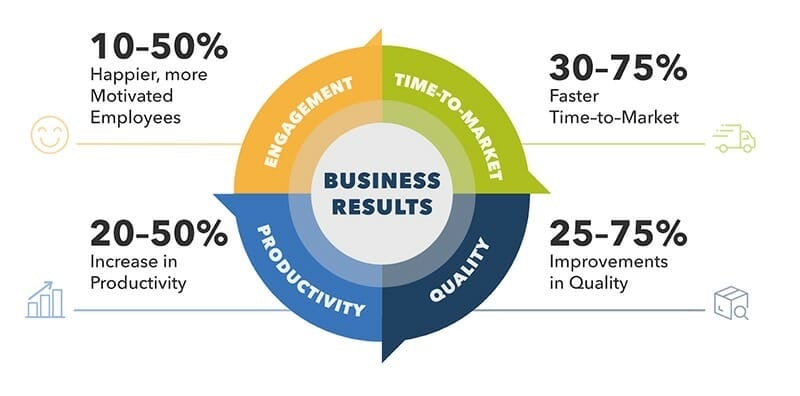The Scaled Agile Framework (SAFe) is a proven knowledge base of practices, competencies, and integrated principles for achieving and sustaining business agility at scale. Over 70% of the Fortune 100 US companies, and an increasing number of Global 2000 companies, have certified SAFe practitioners and consultants on site (source: Scaled Agile Inc.). This methodology is great for large systems, with multiple teams or pods, that want to deliver systemic value faster, get real-time customer feedback, and be adaptable to change.
To quote Dean Leffingwell, the creator of SAFe, “achieving Business Agility means that the entire organization, not just development, is engaged and continually and proactively delivering innovative business solutions faster than the competition.”
How Can SAFe Help My Organization?
SAFe’s flexible structure ensures your organization can consistently advance its most complex programs. When properly executed, SAFe can help alleviate some of your company’s most costly pain points.
- Puts the customer first, and customer centricity is a mindset and a way of doing business
- Enables business agility, using a flexible, customizable framework to improve organizational outcomes
- Maximizes the delivery of value through organizational business and technical goal alignment
- Provides repeatable, sustainable and scalable processes and building blocks
- Produces large scale performance and delivery improvements
The Difference Between Waterfall, Agile, and Scaled Agile (SAFe)
Waterfall was one of the first traditional methodologies for software development. It assumes resources work in silos, and that each department works independently to finish their work before handing it off to the next group for the next part of the process. No value is provided to the customer until the very end of the process, often times years later. This approach provides no transparency or visibility, and no collaboration or cross-communication between the various groups. Waterfall processes have proven to be slower and less effective than newer Agile approaches.
Agile methodologies remove the silos and encourage all resources to work together to deliver ongoing increments of value. Small working timeboxes (sprints) are used, and value can be delivered to the customer at the end of each sprint. An Agile approach gets value in the customers’ hands faster and opens the feedback loop sooner.
As our world grows more global and complex, there is a need to scale these Agile methodologies. The Scaled Agile Framework (SAFe) uses Agile as its foundational building block, but also provides a way for larger systems with many teams across many locations, to all work in-sync and in-cadence to continuously deliver value together. SAFe processes focus on transparency, built-in quality, alignment and program execution.
Trusted by Industry Leaders
Over 20,000 enterprises worldwide in nearly every industry trust the Scaled Agile Framework (SAFe). Since 2011, companies have been embracing this methodology to achieve business agility for their organizations and to continually provide value to their customers. SAFe was developed to help organizations successfully operate in today’s increasingly complex and global world.
One particular ceremony credited with being the “secret sauce” that holds the Scaled Agile Framework together is the PI Event, or the Program Increment (PI) Planning Event. Closely aligned with SAFe’s key practices, activities, ceremonies and rigor, the PI Event is a cadence-based activity that serves as the glue to synchronize and align the business and development teams for ongoing delivery of maximum customer value.
The PI Planning Event occurs on a regularly set cadence, typically about every 13 weeks (quarterly). The event identifies the delivery path for all of the teams and external parties, from now until the next PI Event. The process is intended to create team alignment and produce a working plan, including dependency mapping and risks.
SAFe Organizational Benefits
There are many benefits to running a PI Event, and here are the top ones shared by our clients:
- Establishes communication across all team members and stakeholders
- Aligns development and business goals with the business context, vision, and objectives
- Identifies dependencies and fosters cross-team and ART collaboration
- Provides the opportunity for just the right amount of architecture and lean user experience
- Offers (UX) guidance to teams during the sprint process
- Matches demand to capacity and eliminates excess work in the process
- Allows for fast decision making
- Provides a holistic, agreed-upon organizational plan that everyone is working towards

![]()
Today, over 20,000 enterprises worldwide in nearly every industry trust the Scaled Agile Framework (SAFe). Since 2011, companies have been embracing this methodology to achieve business agility for their organizations and to continually provide value to their customers. SAFe was developed to help organizations successfully operate in today’s increasingly complex and global world.

